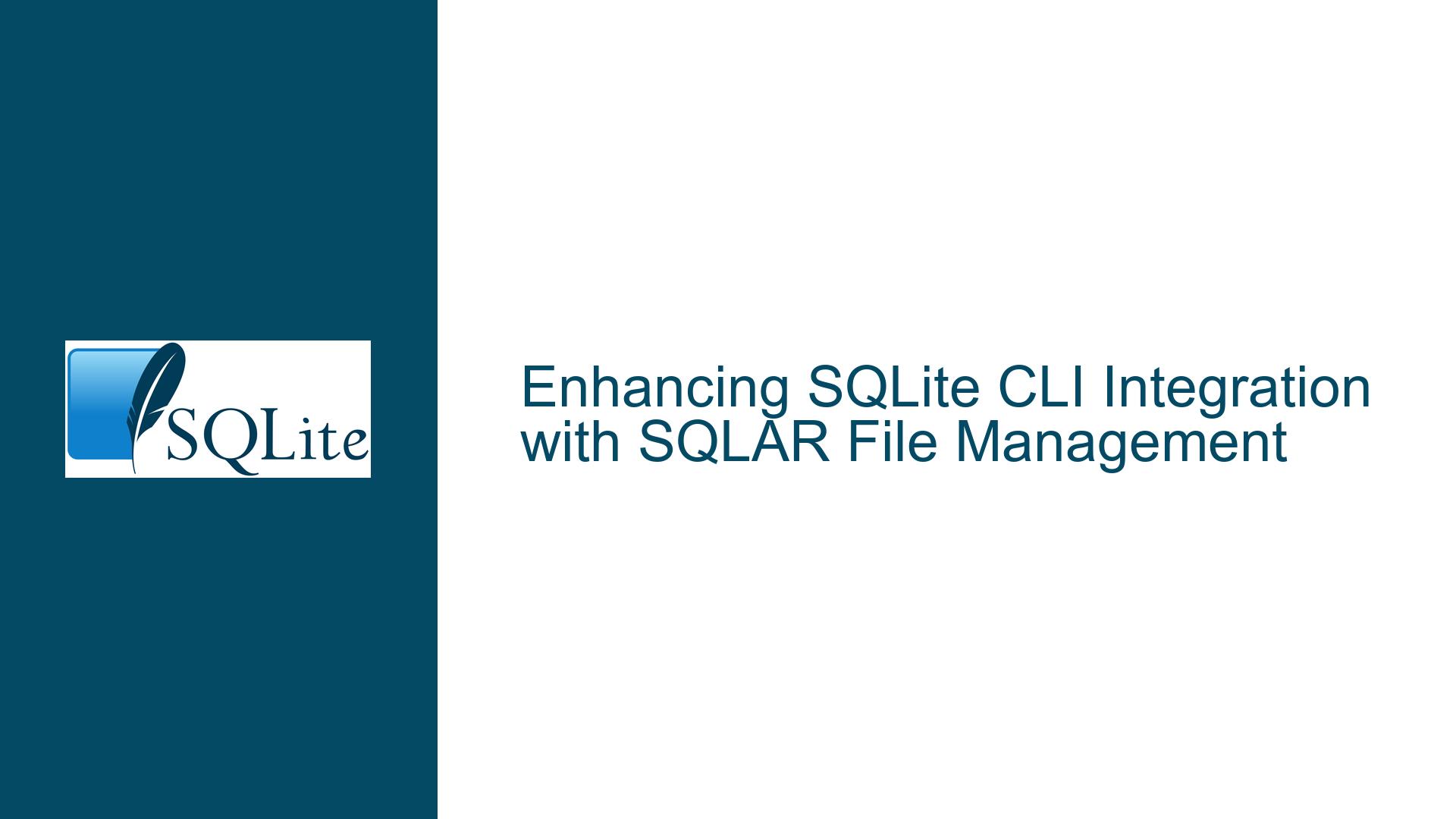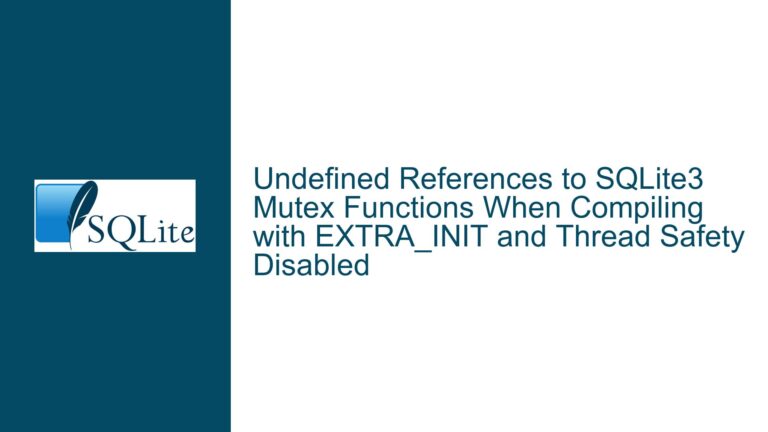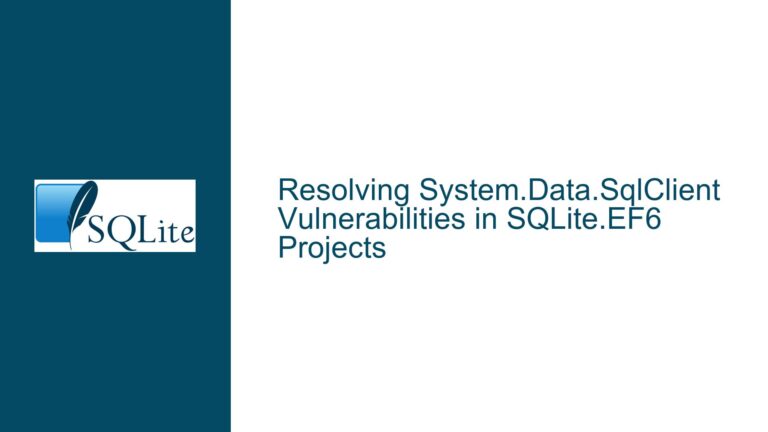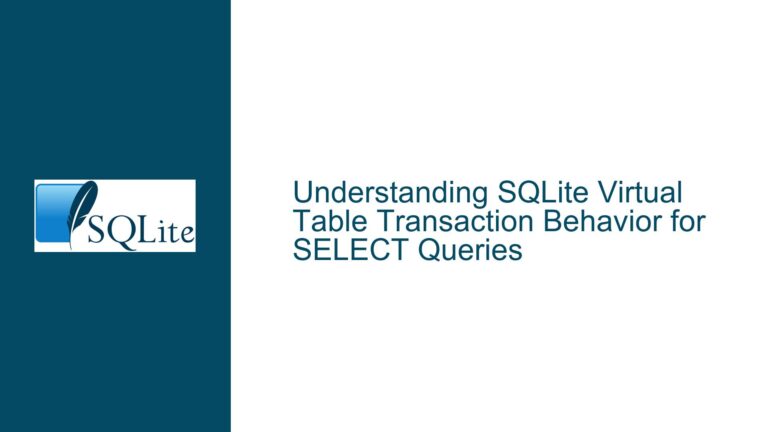Enhancing SQLite CLI Integration with SQLAR File Management
Integrating CLI Dot Commands with SQLAR File Storage: Core Challenges
Issue Overview
The core challenge revolves around extending SQLite’s Command-Line Interface (CLI) to natively support interactions with the SQLAR (SQL Archive) table for file management. The SQLAR table is designed to store files with optional compression, but the CLI’s existing dot commands (e.g., .read, .editor) operate exclusively on the host filesystem. This creates a disconnect between the database-centric storage paradigm and file manipulation workflows. Four specific enhancements are proposed:
.editor <filename>Integration with SQLAR: Launching a text editor to modify a file and automatically saving changes to the SQLAR table instead of the filesystem.- Enhanced
.readCommand for SQLAR: Allowing the.readcommand to execute SQL scripts stored in the SQLAR table. - Command Buffer Editing via SQLAR: Editing the CLI’s active SQL input buffer using a text editor and persisting the buffer’s state to SQLAR.
- Generalized SQLAR Support for File-Operating Dot Commands: Modifying all CLI commands that read/write external files (e.g.,
.import,.output) to optionally interact with SQLAR.
The primary technical hurdle lies in bridging the gap between the CLI’s file-handling logic and SQLAR’s database-centric storage. SQLite’s CLI is designed to treat filesystem paths as the default data source/sink, with no built-in mechanism to redirect these operations to a virtual filesystem like SQLAR. The user’s workaround employs temporary views, triggers, and the edit() SQL function to approximate this functionality, but it requires manual setup, lacks ergonomics, and introduces friction in multi-step workflows.
Architectural and Operational Constraints
The following technical constraints underpin the issue:
- Separation of Concerns: The CLI’s dot commands (e.g.,
.read,.import) are implemented in C as part of thesqlite3executable. They interact with the filesystem via standard I/O functions, unaware of SQLAR’s existence unless explicitly instructed. - SQLAR’s Compression Mechanism: Files stored in SQLAR are compressed using
sqlar_compress(), which defaults to zlib. CLI commands reading from SQLAR must decompress data transparently, while writes must compress data before insertion. - Editor Integration Complexity: The
edit()SQL function launches an external text editor, which operates on temporary files. Redirecting this workflow to SQLAR requires capturing the editor’s output, compressing it, and inserting it into the SQLAR table without leaving filesystem artifacts. - Transaction and Concurrency Safety: Modifying SQLAR during an active transaction or in multi-user scenarios must adhere to SQLite’s locking semantics to avoid data corruption.
The absence of native SQLAR integration forces users to write boilerplate SQL (as demonstrated in the workaround) for basic file operations, undermining the CLI’s usability for project management scenarios where schema and auxiliary files should coexist in a single database.
Systematic Solutions and Implementation Strategies
1. Native .editor Command for SQLAR
Objective: Allow users to edit files stored in SQLAR directly from the CLI using their preferred text editor.
Implementation Steps:
- Step 1: Extend the
.editorcommand to accept an optional--sqlarflag. When invoked as.editor --sqlar 00README.txt, the CLI checks the SQLAR table for a file named00README.txt. - Step 2: If the file exists, decompress its data using
sqlar_uncompress(), write it to a temporary file, and launch the editor (as determined by the$EDITORenvironment variable or a CLI configuration setting). - Step 3: After the editor exits, read the temporary file’s contents, compress them with
sqlar_compress(), and perform anINSERT OR REPLACEinto the SQLAR table. Clean up the temporary file. - Step 4: If the file does not exist in SQLAR, create a new entry with default content (e.g., an empty string or a user-defined template).
Edge Cases:
- Handling Binary Files: If the file is detected as binary (via heuristics like presence of NUL bytes or a
.mode binarysetting), skip decompression/compression and store the raw BLOB. - Editor Exit Codes: Validate the editor’s exit code to distinguish between successful saves and aborted edits. If the editor exits non-zero, discard changes and avoid updating SQLAR.
Example Workflow:
sqlite> .editor --sqlar config.yaml # Opens $EDITOR with config.yaml from SQLAR
sqlite> .archive --list # Confirms the updated file is in SQLAR
2. Augmenting .read to Execute Scripts from SQLAR
Objective: Enable execution of SQL scripts stored in SQLAR using the .read command.
Implementation Steps:
- Step 1: Modify the
.readcommand to support a--sqlarflag. For example,.read --sqlar setup.sqlwould fetchsetup.sqlfrom the SQLAR table. - Step 2: Decompress the script’s data using
sqlar_uncompress(), write it to a temporary file, and execute it as if passed to.read. - Step 3: Add error handling to report missing files or decompression failures.
Alternative Approach: Implement a virtual filesystem layer (using SQLite’s VFS API) that maps SQLAR entries to virtual files. This would allow .read @sqlar/setup.sql syntax without modifying existing commands. However, this approach is more complex and risks incompatibility with some CLI features.
Example Workflow:
sqlite> .read --sqlar migrations/001_init.sql # Executes script from SQLAR
3. Command Buffer Editing with SQLAR Persistence
Objective: Allow users to edit the CLI’s active SQL buffer in an editor and save the buffer’s state to SQLAR.
Implementation Steps:
- Step 1: Introduce a new command,
.buffer --edit-sqlar <name>, which dumps the current command buffer to a temporary file, launches the editor, and upon save, stores the buffer in SQLAR under<name>. - Step 2: Add a
.buffer --load-sqlar <name>command to load a previously saved buffer from SQLAR. - Step 3: Ensure buffer data is stored as plain text (no compression) unless specified via an additional
--compressflag.
Example Workflow:
sqlite> SELECT * FROM users WHERE ... # Partially typed query
sqlite> .buffer --edit-sqlar current_query # Edit in $EDITOR, save to SQLAR
sqlite> .buffer --load-sqlar current_query # Restores the edited query
4. Generalized SQLAR Support for File-Operating Commands
Objective: Extend all CLI commands that interact with filesystem paths to optionally read/write from SQLAR.
Target Commands: .import, .output, .excel, .json, etc.
Implementation Strategy:
- Step 1: Adopt a unified syntax for specifying SQLAR sources/destinations, such as
sqlar:<name>in place of a filesystem path. For example:sqlite> .output sqlar:query_results.csv # Redirects output to SQLAR entry sqlite> SELECT * FROM table; sqlite> .output stdout - Step 2: Modify each command’s implementation to check for the
sqlar:prefix. If present, route data through SQLAR instead of filesystem APIs. - Step 3: For commands like
.import, decompress SQLAR data on read; for commands like.output, compress data before writing to SQLAR.
Compression Handling: Introduce a --compress-level option to control zlib’s compression level (0 for none, 1-9 for varying ratios).
Example Workflow:
sqlite> .import --csv sqlar:data.csv my_table # Imports from SQLAR
sqlite> .mode json
sqlite> .output sqlar:report.json # Writes JSON output to SQLAR
sqlite> SELECT * FROM audit_log;
Cross-Platform and Security Considerations
- Editor Configuration: Allow users to configure the editor path/command via
.sqlitercor environment variables, with fallbacks to$EDITOR/%EDITOR%. - Temporary File Security: Use secure permissions (e.g.,
600) for temporary files to prevent unauthorized access. - Windows Compatibility: Ensure editor launch logic handles spaces in paths and Windows-style line endings when reading/writing SQLAR entries.
Testing and Validation
- Unit Tests: Add test cases to SQLite’s CLI test suite to verify SQLAR integration across all modified commands.
- Fuzz Testing: Test edge cases such as oversized files, invalid compression data, and concurrent access to SQLAR.
- User Feedback: Release the feature as experimental initially, gathering feedback from power users before finalizing the syntax.
Conclusion
Integrating SQLite CLI dot commands with the SQLAR table requires careful extension of existing command implementations, thoughtful handling of compression/decompression, and robust cross-platform file management. By adopting a mix of command-line flags and virtual path syntax, users can achieve seamless interaction with SQLAR, turning the database into a self-contained project repository. These enhancements would elevate SQLite from a mere database engine to a unified data management platform, aligning with its philosophy of simplicity and flexibility.






